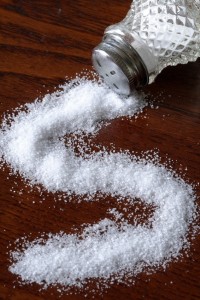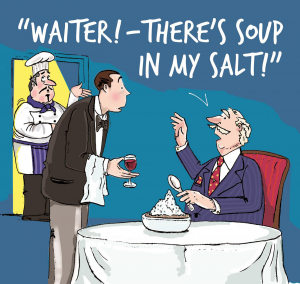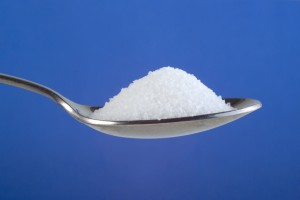 A new study shows the vast majority of parents are unaware of the salt levels present in their children’s breakfast cereals, with health experts worried they could be easily exceeding recommended salt intake levels on a daily basis
A new study shows the vast majority of parents are unaware of the salt levels present in their children’s breakfast cereals, with health experts worried they could be easily exceeding recommended salt intake levels on a daily basis
In a study released today, 85% of parents didn’t factor in salt content when choosing breakfast cereals for their children. Many might ask why they would, when hot debate in this category has been focused on sugar (leaving salt levels largely unnoticed). But with cereal manufacturers under increasing pressure to reduce sugar levels in their products, the two issues aren’t mutually exclusive: salt enhances sweetness.
With two thirds of children eating cereal every day for breakfast, and salt levels still worryingly high in popular cereal choices and other mainstream foods (an innocent homemade ham sandwich* provides over 50% of this age group’s 3 gram daily allowance of salt), experts are concerned that parents could be struggling to bring their children’s diets in at the recommended levels.
The YouGov research, commissioned by healthy food brand BEAR on their launch of the first salt and refined sugar free cereal for children, saw 41% of parents whose youngest child was between 4-6 years old, guessing a maximum daily salt allowance for this child to be higher than the recommended maximum amount. 12% guessed this to be 3-6 times higher.
The need for a salt free start to the day is crucial to reduce future risk of strokes and heart attacks but the more pressing concern during childhood is that a high salt intake leads to loss of calcium, therefore thinning bones and putting children at serious risk of developing diseases like osteoporosis.
Katherine Jenner, Campaign Director of CASH (Consensus Action on Salt & Health) says that research has shown that we only develop a liking for salt through eating salt in food which is why it is important not to give children salty tasting foods.
A reduction of salt intakes across the UK population by just 1 gram a day is estimated to prevent 6,000 strokes and heart attacks a year as well as have other health benefits for the population. Salt is not needed in cereal.
Here to tell us more about the research and how parents can avoid giving their children too much harmful salt are Sonia Pombo of CASH and founder of healthy food brand BEAR, Hayley Gait-Golding. Interviewing them on behalf of PatientTalk.Org is Lauren Beslaw.
BRESLAW I’m joined by Sonia from CASH and Hayley, founder of BEAR. They are discussing a new study that shows that the vast majority of parents aren’t aware of salt levels in their children’s breakfast cereals. This is leading health experts to worry that they could be easily exceeding the recommended salt intake levels on a daily basis.
So what’s the best possible breakfast for a child?
SONIA POMBO: I think there are lots of potentially great breakfasts a child could have. I think that currently when parents go out to supermarkets there is a lot of almost, bewildering choices available for them. There are so many cereals and obviously the ones that children seem to want the most tend to be full of refined sugars and salt. So I think a great breakfast for children would be something like our BEAR Alphabites which we have made with no refined sugar and importantly no salt and also things like porridge, fruit that’s a great start to the day. You want something without the refined sugars so you get nice steady energy and without the added salt too.
BRESLAW Is there any special advice you’d give for children with allergies and food intolerance?
SONIA POMBO: With regards to cereals or just in general?
BRESLAW Generally.
SONIA POMBO: Well definitely if they do have any allergies then they need to get a check-up by the doctor, make sure that they are aware of which allergies they have and then just check the back of food packaging to make sure they double check any of those allergens are not involved in the boxes. So for example dairy don’t drink any milk. If you are allergic to nuts, some cereals although they may not contain nuts they may be produced in the same factory that has nuts so always be cautious and double check the back of the pack.
BRESLAW So why is salt bad for us?
SONIA POMBO: The main reason, not just for children but for adults, is that it puts up our blood pressure and that’s the main cause of strokes, heart attacks and heart failures which is the biggest cause of death, not just in the UK but worldwide and although people associate having a high blood pressure with adults especially with the elderly, it’s definitely something that can start up as young as in childhood. So if you have high blood pressure as a child that will most likely lead on to having high blood pressure in adulthood as well but just focusing on children, it’s especially important not to have a high salt diet as it affects the amount of calcium that’s absorbed in your bones and as we know while children are growing their bones are getting stronger and absorbing as much calcium as they can and with salt preventing this from happening then it could lead to problems later on in life such as osteoporosis and just having more brittle bones.
BRESLAW Why do we need salt?
SONIA POMBO: Well we need salt for, that’s a very good complicated question. We need salt, although a very minimal amount which can easily be found naturally in foods, we need it just for our systems to work properly. It’s involved in a number of nerve systems and also in making sure that our body retains the right amount of water and all the vitamins and nutrients etc. So there is definitely a need for salt but it’s not really an issue for us because the amount of salt that we are having huge. At the moment we’re as a nation, having about 8.1 grams of salt a day. We probably don’t need even more that 1 gram a day so it’s something that we to try and combat, not just individually but as a nation and within the food industry and government.
HAYLEY GAIT GOULDING: Yes and we’ve recently done some work with Amanda Ursell who is a very respected nutritionist and we looked at the types of typical days, what a conservative estimate would be of what children in the UK would be consuming a day and they are already consuming around 7 grams a day and like I said that is a conservative estimate and you know if you think a 4 – 6 year old the maximum they are allow a day is 3 grams. So that is at the upper limit, 3 grams but they are already more than double of what they should be having and like I said that was a very, very conservative estimate that we took so it could be very close to what adults are consuming, around 8 grams that children are having and that’s like Sonia said, is going to cause their bones to lose calcium. Salt saps calcium from their bones and that that weakens over time and children are building that bone bank. So I think it’s really important that manufacturers follow in our footsteps and take salt out of cereals because there is not technical reason you need salt in cereals. It’s probably the one meal a day where you could quite easily say, do you know what, let’s get rid of that salt and it would give people a much better start to the day.
BRESLAW Are there any alternatives to salt available?
HAYLEY GAIT GOULDING: In terms of alternatives I’m guessing that you mean ingredients, is that
right?
BRESLAW Yes, that tastes similar.
HAYLEY GAIT GOULDING: Yes, the reason salt is in products is, it varies by product so salt has a technical function for some foods so it has some sort of interaction, I think it is with the yeast although don’t quote me on this, for break it makes break rise but like I say, when it comes to cereal there is no technical reason so you could take it out. Why don’t manufacturers do that? It’s probably is going to make the cereals taste a bit bland because like you say, you have to find an alternative ingredient. Just a better ingredient and what we think at BEAR is nature is always better. We only use 100% natural ingredients, we don’t use any refined sugars or salts or anything artificial. We go into nature and we look for the answer. So we found that up a coconut tree, we found coconut blossom nectar which is a lot GI product. It’s the sweet sap that is found in the flower of the coconut tree, it doesn’t have any coconut taste it’s just naturally sweet. If you add that to your whole grains and mix it together it gives you a nice, sweet, crunchy cereal that kids really enjoy. It doesn’t have that bland taste often associated with healthy cereals.
BRESLAW How can we reduce salt in our diets?
HAYLEY GAIT GOULDING: There’s lots of ways you can look to reduce salt in your diets. I think, like I say, the number one thing that we are hoping to help people do is start the day salt free. That’s a really important thing to do because already that tips the scales. Sonia talked earlier about how much salt that you do actually need. If you think that a very small bowl of breakfast cereal which 30 grams, which is what people say on the portions but that is actually really small and I don’t think it is that realistic that many people are having a 30 gram bowl but that has 0.5 gram typically, of salt in most of the very well-known brands that we all buy and if your child is supposed to have 3 grams a day you can see that that’s already a lot. So if you took that out of breakfast that’s already giving you a head start makes the rest of the day less of a worry and then just make sensible choices throughout the day. So cut down on things like ketchups and stuff that might be really salty or buy or buy low salt versions. Switch salty snacks like crisps and maybe some cheeses, watch out for some cheeses, they have got quite a lot of salt in. Things like that just switch them for fruit or yoghurt, things that are salt free. Pick a few salt free things throughout the day and then start taking out those little surprising things like, humus or ketchup could be quite high.
BRESLAW So with the study that you conducted what was the methodology and the conclusions?
HAYLEY GAIT GOULDING: So we took a nationally represented study of 1,178, to give you a precise number of people. We did that together with YouGov and the conclusions that we found from the study was that 85% of parents said that they didn’t even consider salt when it came to making the decisions about what to give their children for breakfast. They were thinking about very high sugar a levels which is good, that’s a really great thing. There has been a lot of media focus sugar over the last few years but I think salt really needs to come under the agenda now equally because it has equally negative health implications. So that was one of the findings. The other finding was that two thirds of families have cereals for breakfast and I think Sonia will probably tell you a little bit about that, like how much cereals contribute and cereals and cereal products contribute to breakfast.
SONIA POMBO: Yes definitely. If you look at the latest government national diet and nutrition survey that was done in 2011 they actually found that cereals and other cereal products contributed to over a third of a child’s salt intake. So that’s a huge amount that you’re contributing and removing that as BEAR have you are already reducing the salt intake of a child’s diet by that third and giving them a better start to the day but by far most of the salt that we do consume isn’t from what we add to the food ourselves, its already in the foods that we buy. So breads, cereals, cheeses are a very big contributor. Cured meats so ham, bacon, sausage all the things that people tend to love but they are completely coated in salt and it’s just a matter of trying to remove that slowly and gradually that people don’t notice and their taste palettes, the palettes in their mouth will adapt to the level of salt really.
HAYLEY GAIT GOULDING: One other thing you might be interested in knowing about with what was found, what came out of the research was that 61% of parents when they gave their children lower sugar cereals, so things were either without sugar, so things like porridge or things like Weetabix which have less sugar, they were saying that they added it back so that’s also something interesting to think about when comes to health. Sometimes when people are choosing these lower sugar alternatives they are adding it back in refined sugar which kind of defeats the object. So that’s why it’s really important to try and find natural ways. So if you are going to another brand of lower sugar cereals, try and sweeten it with fruit or buy something like BEAR Alphabites which doesn’t have the added sugar or porridge, add something which is a healthier lower GI sweetener. Try to think about as many of those things, I know it can all be a bit overwhelming but try and think about as many of those things as you can.
BRESLAW Finally, what online information would you recommend?
HAYLEY GAIT GOULDING: There are two great places to go to for information. There’s the CASH website which is you type into any search engine ‘CASH salt’ it will come up and they’ve got absolutely loads of amazing information on salt specifically. If you are looking for a bit more general information about healthy breakfast or healthy food products we’ve also got some nutritional information at BEAR and that’s www.bearnibbles.co.uk
BRESLAW Thank you very much



